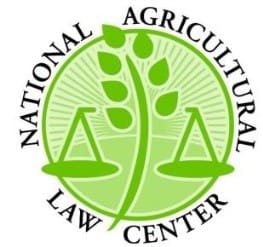A comprehensive summary of today’s judicial, legislative, and regulatory developments in agriculture and food. Email important additions HERE.
ANNOUNCEMENT: Mark your calendar for the next Agricultural & Food Law Consortium webinar, Wednesday, September 5th: Be In The Know: Legal Tips for Your Ag Start-Up. Details available here.
JUDICIAL: Includes renewable energy, agritourism, food labeling, and water rights issues.
In GREEN GAS DELAWARE STATUTORY TRUST, Methane Bio, LLC, Tax Matters Partner, et al., Appellants v. COMMISSIONER OF INTERNAL REVENUE SERVICE, Appellee, No. 17-1025, Consolidated with 17-1026, 17-1027, 2018 WL 3893186 (D.C. August 14, 2018), appellants sought tax credits related to a landfill gas-collection facility that sold electricity from landfill gas. Appellants claimed over $11 million in tax credits from “venting/flaring landfills,” and issue was whether the claims could be made during periods when venting or flaring was used. Tax Court did not allow the credits and reasoned that venting/flaring landfills “do not qualify as a ‘facility for producing qualified fuels,’ because they are not meant to produce energy and do not capture any fuels which could be used by someone else for that purpose.” Appellate court agreed with Tax Court and affirmed.
In STATE of Vermont v. Ronald DUPUIS, No. 2017-344, 2018 WL 3948067 (Vt. August 17, 2018) , defendant was charged with “taking big game by illegal means,” but argued game warden performed an illegal warrantless search of the property in question. Lower court ruled for defendant and issue on appeal was whether Vermont law protects against a warrantless search done “for the purpose of enforcing hunting laws and the landowner has not strictly abided by Vermont’s regulations for posting against hunting.” State argued defendant’s “’no trespass’ postings did not comport with Vermont’s hunting posting statute,” affording him no expectation of privacy. Appellate court affirmed, finding that Vermont laws concerning hunting and trapping do not “create an exemption to the warrant requirement for game wardens investigating hunting violations on private property.”
In STEPHEN HADLEY, Plaintiff, v. KELLOGG SALES COMPANY, Defendant, No. 16-CV-04955-LHK, 2018 WL 3954587 (N.D. Cal. August 17, 2018), plaintiff sought class certification after alleging defendant provided misleading statements on its cereal products. Plaintiff maintained the terms “healthy” “nutritious” and “wholesome” are misleading because of the high sugar content in defendant’s cereals. Defendant argued class certification should not be granted because “the evidence indicates that consumers of the products at issue did not have a uniform, ‘common understanding’ of many of the challenged health statements.” The court disagreed with defendant’s argument and observed that “deception and materiality under the FAL, CLRA, and UCL are governed by an objective “reasonable consumer” test.” Plaintiff’s motion granted in part.
In CROW CREEK SIOUX TRIBE, Plaintiff-Appellant v. UNITED STATES, Defendant-Appellee, 2017-2340, 2018 WL 3945585 (Fed. Cl. August 17, 2018), an Indian tribe sought damages and an injunction “for the alleged taking of its water rights in violation of the Fifth Amendment, and for the alleged mismanagement of its water rights.” Claims Court dismissed for lack of subject-matter jurisdiction. Appellate court recognized case law stating that “establishment of an Indian reservation impliedly reserves the amount of water necessary to fulfill the purposes of the reservation.” The court also noted that “water is only reserved for the Tribe . . . to the extent needed to accomplish the purpose of the reservation.” Court found that plaintiff’s complaint “does not allege that the amount of water flowing by the Reservation and available for the Tribe’s use is insufficient to fulfill the purposes of the Reservation.” Affirmed.
REGULATORY: Includes EPA, FWS, FDA, and NOAA rules and notices.
ENVIRONMENTAL PROTECTION AGENCY:
Rule EPA is approving Alabama’s request and redesignating the Area to unclassifiable/attainment for the 2006 primary and secondary 24-hour PM2.5 NAAQS based upon valid, quality-assured, and certified ambient air monitoring data showing that the PM2.5 monitor in the Area is in compliance with the 2006 primary and secondary 24-hour PM2.5 NAAQS. Info here.
Rule EPA is partially approving and partially disapproving several state implementation plan (SIP) submissions from the State of Arizona pursuant to the requirements of section 110(a)(1) and 110(a)(2) of the Clean Air Act. Details here.
Rule EPA is approving a state implementation plan (SIP) revision submitted by the Commonwealth of Virginia (the Commonwealth or Virginia) on July 16, 2015. Info here.
Rule EPA Region 3 announces the deletion of the Ordnance Works Disposal Areas Superfund Site (Site) located in Morgantown, West Virginia, from the National Priorities List. Info here.
Rule EPA is proposing to approve a State Implementation Plan (SIP) revision which Ohio submitted to EPA on April 3, 2015, and supplemented in October 2015 and March 2017, as its plan for attaining the 1-hour sulfur dioxide primary national ambient air quality standard for the Lake County nonattainment area. Info here.
FISH AND WILDLIFE SERVICE: Rule FWS designates critical habitat for Bidens micrantha ssp. ctenophylla (kookoolau), Isodendrion pyrifolium (wahine noho kula), and Mezoneuron kavaiense (uhiuhi) respectively, under the Endangered Species Act. Info here.
FOOD AND DRUG ADMINISTRATION: Notice FDA is announcing the availability of a final guidance for industry entitled “Quality Attribute Considerations for Chewable Tablets.” Info here.
NATIONAL OCEANIC AND ATMOSPHERIC ADMINISTRATION:
Rule NMFS is prohibiting directed fishing for Pacific ocean perch in the Central Aleutian district (CAI) of the Bering Sea and Aleutian Islands management area (BSAI) by vessels participating in the BSAI trawl limited access fishery. Info here.
Rule NMFS is reallocating the projected unused amount of Pacific cod total allowable catch (TAC) from vessels using jig gear and catcher vessels greater than or equal to 60 feet (18.3 meters (m)) length overall (LOA) using hook-and-line gear to catcher vessels less than 60 feet (18.3 m) LOA using hook-and-line or pot gear in the Bering Sea and Aleutian Islands management area. Details here.
